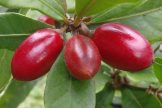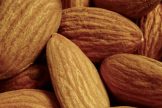
In July we are at the end of Waring or Wombat season. This is the time for the lowest temperatures and highest rainfall. A time when the wombats come out to catch the sun’s rays, and the male lyrebirds are busy singing every other bird’s song in order to attract a mate.
Although it is the middle of winter, the shortest day of the year is now behind us. Despite the cold, there is lots to appreciate in the garden and parklands. The Grevilleas are hitting their stride with flowers bursting. The Leucadendrons are also showing lots of colour and the intoxicating perfume of the winter sweet is sure to lift the spirits. The brussels sprouts planted in February should be swelling to a size ready to pick – hopefully they have encountered a frost to sweeten them. Eureka lemons are dripping off the trees for that Vitamin C hit – much in need this winter!
Plan now what your summer vegie patch will hold. Towards the end of July the tomato seeds will be in stock for all those early birds.
The nursery now has a full range of deciduous trees and shrubs, both ornamental and fruiting, berry canes and roses.. Grapes are due… Our bare root stock are potted to ensure the new roots don’t have the chance to dry out, to maximise success once planted in your garden, but they are still available at very reasonable prices. If you need some help selecting a tree or rose, come in and ask our expert nursery staff for advice. We have a fact sheet on planting bare root stock.
Deciduous shrubs are often over looked, but can be a handy solution for that tricky west facing position that gets no sun in the winter and too much in summer. Check out our page, deciduous shrubs that pack a punch, for some showstoppers. Now is the best time to plant these guys as they are dormant or ‘asleep’. When these plants are having their winter rest, they are very robust and easy to handle. Transplant shock is minimised and don’t worry that they look like sticks now because boy, will they take off in spring.
Edible Gardening
We have a huge range of fruit trees to choose from including almonds, chestnuts, hazelnuts, peaches, pears, apples, apricots, figs, cherries, nectarines, quince, plums and pomegranates. We give the trees their final formative prune in the nursery before they go on the bench. This is very important as it ensures the tree will transplant well and develop a strong branching structure. Those with small gardens can try dwarf fruit trees, such as Ballerina apples, nectarines, peaches and peaches or espalier an apple or citrus tree to create structure and maximise sunlight to your garden. Also fun to try are berries – try a currant or blueberry bush (very decorative as well as delicious!) or decorate your fences and pergolas with grape vines, kiwi fruits, passionfruit or loganberries. In addition to trees, shrubs and vines, don’t forget the subterranean wonders of the season such as rhubarb, asparagus, certified seed potatoes and shallots. All are now available in the shop and the produce area and it’s exciting to watch the emergence of these in early spring.
The nursery also has a variety of cool season vegies and herbs in stock. Plant broccoli, cabbages, leeks and cauliflowers to make warming winter soups. Many of the Asian-style, green, leafy vegies are better grown through the cooler season as they don’t bolt to seed – just pick them as you need them. Remember to dig in plentiful amounts of cow manure and mushroom compost to feed these hungry plants quickly.
Asparagus and rhubarb are grown now from bare-root crowns in rich, well drained and composted soil. If they are planted in a sunny part of the garden and can be left undisturbed, you are in for a delicious crop year after year. They are both well-suited to surviving drought conditions. Lettuces can still be planted now along with vegie seedlings of beetroot, broccoli, carrots, chives, radish, silverbeet, snow peas, onions and cabbage. Plant your coriander now and it won’t bolt as it does when warmer. Broadbeans can be grown right through winter, as can peas. There are both low-growing and taller growing varieties available. The taller ones will need staking.
Potatoes have a different taste and texture altogether when dug freshly out of the ground. Choose a variety you like and then grow your own. It is best to use seed potatoes as they are certified disease free. They love fertile soils and lots of tucker and as long as the soil is kept mounded around the growing mass of foliage, more and more potatoes will be harvested.
Edibles to plant in Melbourne in July.
Below is a list of edible gardening seeds and seedlings that can be planted in July. Please keep in mind that this list has been developed for Melbourne’s climate. Some of the plants indicated will be either right at the start or the end of their ideal planting season, click the links to the factsheets for more detailed planting information.
 – Seeds – Seeds – Seedlings – Seedlings
|
 – Tubers / Crowns – Tubers / Crowns – Companion Plants – Companion Plants
|
 – Protect from frost – Protect from frost – Prone to Cabbage Butterfly – Prone to Cabbage Butterfly
|
Angelica Arrowroot  Artichokes (Jerusalem)  Asparagus  Bok Choy  Beetroot   Broccoli   Broccoletti   Broccolini   Broad Beans  Cabbage    Carrot  Cauliflower  Chamomile   Chervil  Chicory  Chives  Coriander  Cress  Curry Plant  Endive 
|
Feverfew  Garlic  Giant Red Mustard  Good Bug Mix   Kale   Kohlrabi  Lemon Balm  Lettuce   Lovage  Marjoram  Mint  Mitsuba  Mizuna  Mustard Greens   Mustard Mizuna  Onion  Oregano  Pak Choy / Bok Choy  Parsley  Peas  Radicchio  
|
Radish  Rhubarb  Rocket / Arugula  Rosemary  Saffron Crocus  Sage   Salad Burnett  Savory   Shallots  Silverbeet  Spring Onion   Sorrel  Strawberries  or runners or runnersTarragon   Tatsoi   Thyme  Warrigal Greens   Wasabi  Watercress  Witloof  
|

Drainage
Keep an eye out for drainage problems in the garden. This is evident if water pools on the surface after rain or the ground stays soggy and muddy well after surrounding areas have dried off. Use gypsum or clay breaking liquid to break up clay soils. Adding compost and organic matter will also improve drainage. These spots may be ideal for plants that are suited to waterlogged areas or experiment with surface contouring. If you are concerned about drainage, creating mounded beds can solve a lot of problems.
Frost
Fuchsias, hibiscus, luculia, gardenias and other tender plants may need protection from the frost. There are several ways to protect plants from frost including covering plants at night, using frost covers and watering the foliage. Some vegetables may also suffer from frost damage if they are flowering at the time, such as potatoes and peas.

July is the perfect time to prune roses and most deciduous trees including stone and pome fruit trees. Do not prune your apricot tree now nor any spring flowering trees and shrubs yet, wait until after they have flowered. This includes some roses which flower only once, such as the Banksia roses. Tidy herbaceous plants by cutting back dead and dying foliage flowers and stems. Lift and divide established perennials.
We have a lot of fact sheets on pruning – type ‘pruning’ into the search box on our web page and 15 fact sheets will pop up – all discussing pruning.
To protect soft new growth after cutting back perennials, cover them lightly with pea straw or lucerne to prevent frost damage.
Spraying copper sulphate on the bare stems after pruning can help prevent fungal disease.
Prune deciduous clematis back to a pair of plump buds approximately 60 cm from the ground and remove any weak shoots altogether.
Keep in mind that fruit trees in home gardens are often intended to be ornamental as well as fruitful, so this will help determine the shape you would like your tree to have. If it is strictly for the fruit, then read on.
Pruning sweet cherries, European and Japanese plums, apricots
Prune to an open vase shape in the young tree to develop its shape. No annual winter pruning is then required after the first three years, except to remove dead or diseased wood, or branches crossing over one another and rubbing. Apricots are best left in winter and pruned in early autumn, to reduce the risk of fungal disease entry.
Peach, nectarines
Remove a third to a half of the previous year’s growth, including any internally growing branches and thinning out any weak side-shoots.
Apples, pears
These can develop very well with only a little pruning to remove weak growth. It’s important that an open-centred vase shape is promoted to allow for maximum sunlight penetration into the centre, so prune out any internal, inward-growing branches. Shorten sideshoots to leave 3 to 4 buds. If there are any vigorous side branches, tie them to keep them horizontal as this will force them to become fruit-bearing wood.
This is a fungal disease that infects peaches, nectarines, almonds and other Prunus species. The symptoms are noticed in spring and summer, when the leaves appear with raised lumpy light green and red patches and are curled up. This problem weakens the tree if it occurs year after year, and will result in a reduced fruit yield. Once you see the symptoms, it is too late to spray. The trees should be sprayed from mid to late winter from bud swell, until the leaves emerge. Spray with copper sprays such as copper oxychloride during this period. This is a preventative spray, so the swelling buds need to be covered with the copper spray. Once the buds have burst open, it is too late to spray. The nursery puts up signs when we spray our peaches, nectarines and almonds to remind you when to spray your own trees at home.
Kids in the Garden
Make a living teepee! Bind together up to 5 bamboo stakes with string, spread out the base and place it firmly in some soil in your garden. Tie more string at different intervals between the stakes for the plants to grow along. Plant snow-pea seedlings at the base of each bamboo stake and as they grow, gently train them along the string. Soon you’ll have a living teepee that you can eat off!





